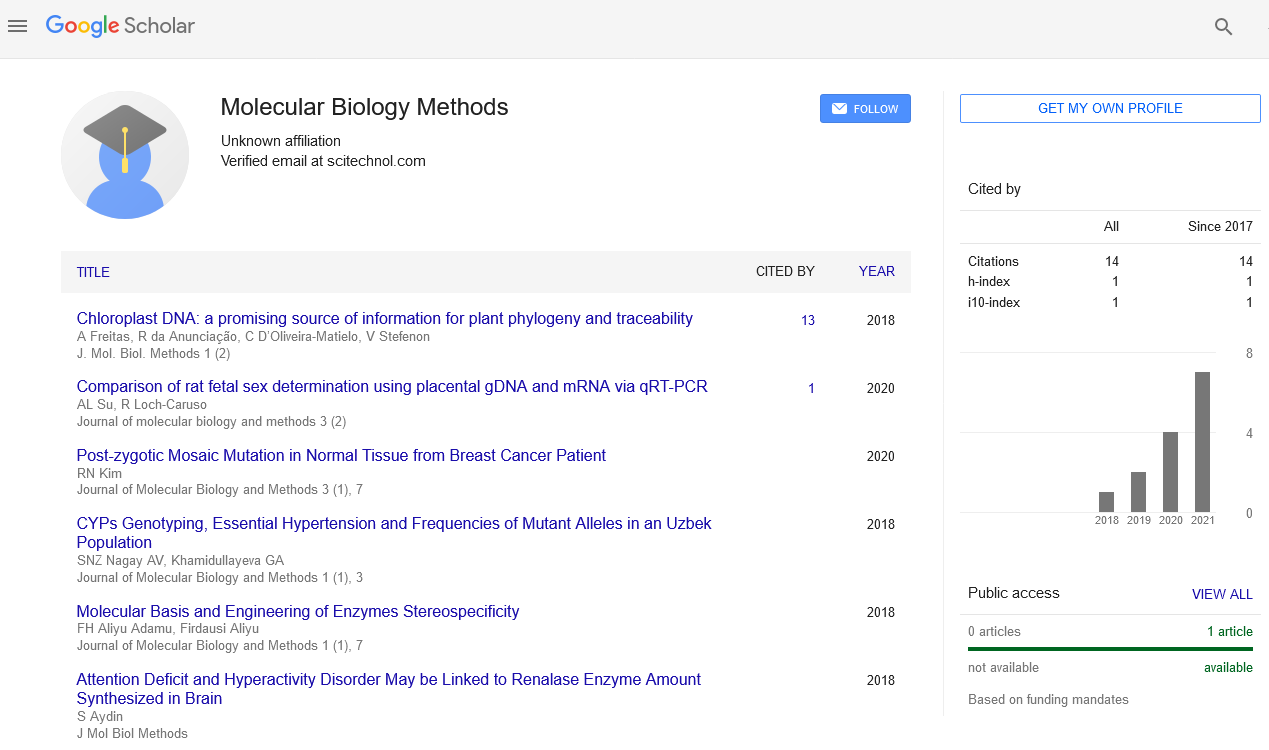Editorial, J Mol Biol Methods Vol: 4 Issue: 5
The Genetic Material is known as Mitochondrial DNA or mtDNA
Thiemann Otavio Henrique*
Department of Genetics and Evolution, Federal University of São Carlos, Carlos, Brazil
*Corresponding author: Thiemann Otavio Henrique, Department of Genetics and Evolution, Federal University of São Carlos, Carlos, Brazil, E-mail: thiemann@ifsc.usp.br
Received date: September 02, 2021; Accepted date: September 19, 2021; Published date: September 26, 2021
Keywords: Mitochondrial, DNA
Introduction
DNA (deoxyribonucleic acid) is the nucleic acid polymer that forms the genetic code for a cell or virus. Most DNA molecules consist of two polymers (double-stranded) of four nucleotides that each consist of a nucleobase, the carbohydrate deoxyribose and a phosphate group, where the carbohydrate and phosphate make up the backbone of the polymer. DNA content is the most frequently measured cellular constituent. Its quantification serves to assess DNA ploidy level, cell position in the cell cycle, and may reveal the presence of apoptotic cells that are characterized by fractional DNA content. Distribution of cells within the major phases of the cell cycle is based on differences in DNA content between the prereplicative phase cells (G0/1) versus the cells that actually replicate DNA (S phase) versus the post-replicative plus mitotic (G2+ M) cells.
Mitochondrial DNA or mtDNA
Mitochondria are structures within cells that convert the energy from food into a form that cells can use. Each cell contains hundreds to thousands of mitochondria, which are located in the fluid that surrounds the nucleus (the cytoplasm). Although most DNA is packaged in chromosomes within the nucleus, mitochondria also have a small amount of their own DNA. This genetic material is known as mitochondrial DNA or mtDNA. In humans, mitochondrial DNA spans about 16,500 DNA building blocks (base pairs), representing a small fraction of the total DNA in cells.
This unit covers general aspects of DNA content analysis and provides introductory or complementary information to the specific protocols of DNA content assessment in this chapter. It describes principles of DNA content analysis and outlines difficulties and pitfalls common to these methods. It also reviews methods of DNA staining in live, permeabilized, and fixed cells, and in cell nuclei isolated from paraffin-embedded tissues, as well as the approaches to stain DNA concurrently with cell immunophenotype. This unit addresses factors affecting accuracy of DNA measurement, such as chromatin features restricting accessibility of fluorochromes to DNA, stoichiometry of interaction with DNA, and “mass action law” characterizing binding to DNA in relation to unbound fluorochrome concentration. It also describes controls to ensure accuracy and quality control of DNA content determination and principles of DNA ploidy assessment.
DNA -Biologists era
During the early 19th century, it became widely accepted that all living organisms are composed of cells arising only from the growth and division of other cells. The improvement of the microscope then led to an era during which many biologists made intensive observations of the microscopic structure of cells. By 1885 a substantial amount of indirect evidence indicated that chromosomes— dark-staining threads in the cell nucleus—carried the information for cell heredity. It was later shown that chromosomes are about half DNA and half protein by weight.
Analysis of fixed cells as opposed to the detergent-permeabilized cells is preferred when there is a need to store or transport samples, e.g., in the case of clinical specimens that cannot be immediately analyzed. Their storage, unless done at low temperature in cryopreservative medium, leads to cell autolysis. Fixed cells, on the other hand, can be stored for months or years. Precipitating fixatives (e.g., alcohols, acetone) are preferred over cross-linking ones (e.g., formaldehyde, glutaraldehyde) for analysis of DNA content. The cross-linking of chromatin impairs stoichiometry of DNA staining and thus decreases accuracy of DNA content measurement (Darzynkiewicz et al., 1984). It should be noted, however, that highly fragmented DNA, such as that present in apoptotic cells, leaks out from the ethanol-fixed cells during their hydration and staining, but is preserved and remains within the cell upon fixation by formaldehyde.
All of the genetic information in a cell was initially thought to be confined to the DNA in the chromosomes of the cell nucleus. Later discoveries identified small amounts of additional genetic information present in the DNA of much smaller chromosomes located in two types of organelles in the cytoplasm. These organelles are the mitochondria in animal cells and the mitochondria and chloroplasts in plant cells. The special chromosomes carry the information coding for a few of the many proteins and RNA molecules needed by the organelles. They also hint at the evolutionary origin of these organelles, which are thought to have originated as free-living bacteria that were taken up by other organisms in the process of symbiosis. We also show that TnpB could be reprogrammed to cleave DNA target sites in human cells. Together, this study expands our understanding of transposition mechanisms by highlighting the role of TnpB in transposition, experimentally confirms that TnpB is a functional progenitor of CRISPR-Cas nucleases and establishes TnpB as a prototype of a new system for genome editing.
 Spanish
Spanish  Chinese
Chinese  Russian
Russian  German
German  French
French  Japanese
Japanese  Portuguese
Portuguese  Hindi
Hindi 